Honor Award
Wormsloe: Reenvisioning a Cultural Landscape
Wes Ryals, Student ASLA, University of Georgia
Faculty Advisor: David Spooner, ASLA and Doug Pardue, Associate ASLA
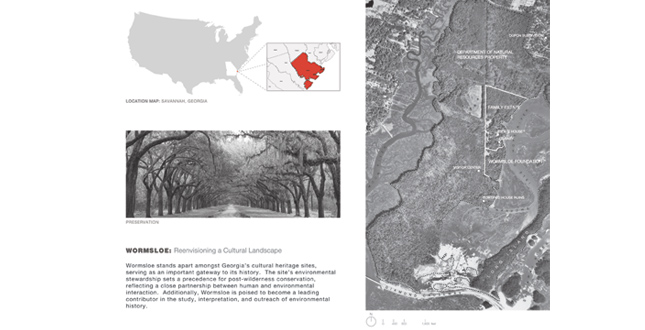
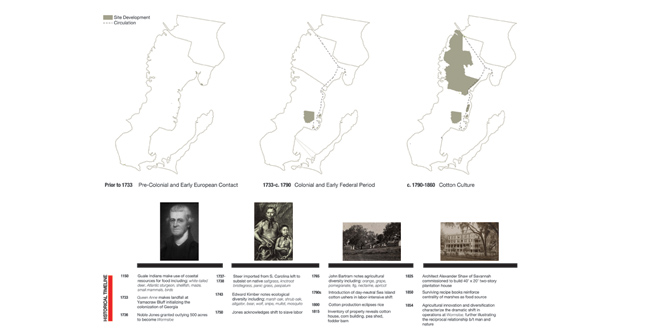

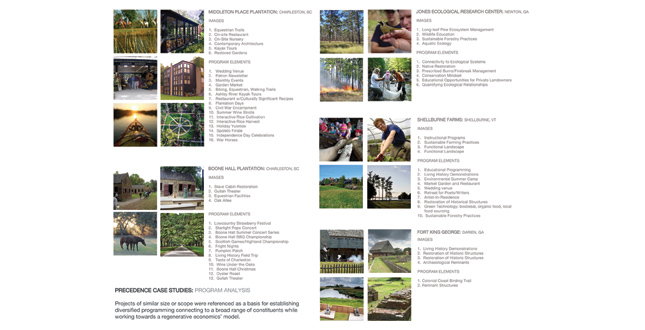 Close Me!
Close Me!Precedence Case Studies: Program Analysis. Projects of similar size or scope were referenced as a basis for establishing diversified programming connecting to a broad range of constituents while working towards a regenerative economics’ model.
Download Hi-Res ImagePhoto: Wes Ryals
Photo 4 of 15
 Close Me!
Close Me!Cultural Landscape Report: Basis for Design Development. In order to be considered on the National Registry of Historic Places, the property must undergo a Cultural Landscape Report. The report shall be critical in yielding new information relevant to program development. Additionally, the report fosters non-destructive methods and lends itself to low-impact development.
Download Hi-Res ImagePhoto: Wes Ryals
Photo 5 of 15
 Close Me!
Close Me!Archaeology Analysis: Incremental Program Phasing. The archaeological process shall be included in the education experience. Supplementary program focus provides added layers of complexity to the landscape. Additionally, portable audio devices can be utilized on site to gain access to previous exhibits, enabling individually-tailored experiences.
Download Hi-Res ImagePhoto: Wes Ryals
Photo 6 of 15
 Close Me!
Close Me!System Analysis: Spatial Relationships. Connectivity throughout the site has been achieved while minimizing impact to sensitive areas. Vehicular access has been minimized in favor of maximizing the experiential quality of the landscape while encouraging the recovery of natural systems.
Download Hi-Res ImagePhoto: Wes Ryals
Photo 7 of 15
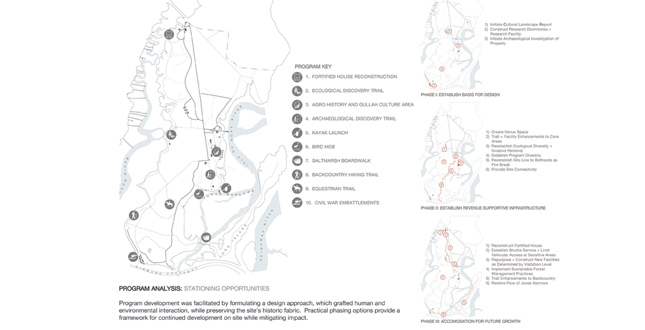 Close Me!
Close Me!Program Analysis: Stationing Opportunities. Program development was facilitated by formulating a design approach, which grafted human and environmental interaction, while preserving the site’s historic fabric. Practical phasing options provide a framework for continued development on site while mitigating impact.
Download Hi-Res ImagePhoto: Wes Ryals
Photo 8 of 15
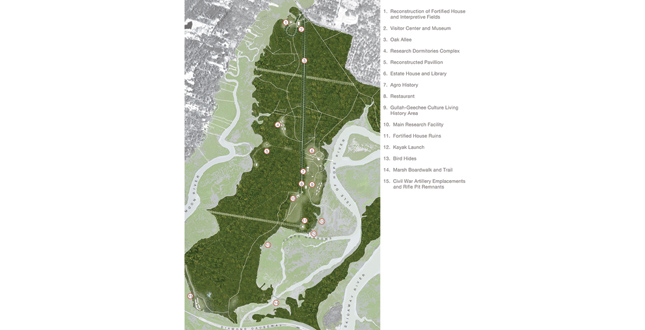
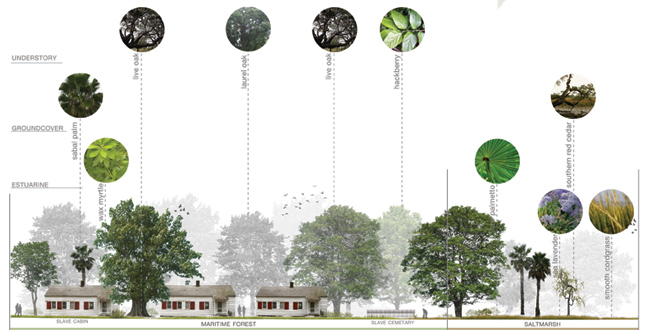 Close Me!
Close Me!Historical Restoration: Establishing Historical Connectivity. Historical programming focuses on presenting a holistic experience, infusing the natural landscape with the built environment. A renewed focus has been placed on integrating the cultural influence of Africans in transforming the landscape while providing a broader connection to the proposed Gullah/Geechee heritage corridor.
Download Hi-Res ImagePhoto: Wes Ryals
Photo 10 of 15
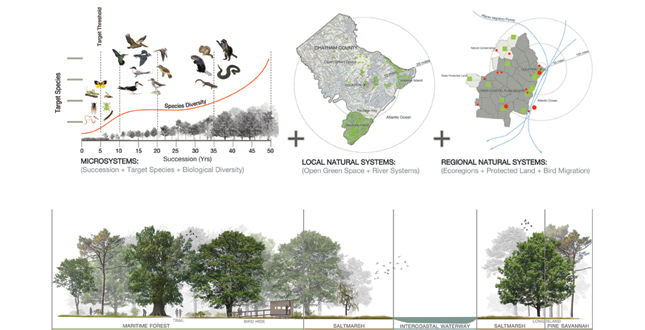 Close Me!
Close Me!Ecological Diversity + Restoration: Establishing Ecological Connectivity. Restoring ecological diversity constituted a bottom-up approach, initially focusing on functioning members of selected ecosystems before connecting to a much broader systems network focusing on green space connectivity and wildlife corridors.
Download Hi-Res ImagePhoto: Wes Ryals
Photo 11 of 15
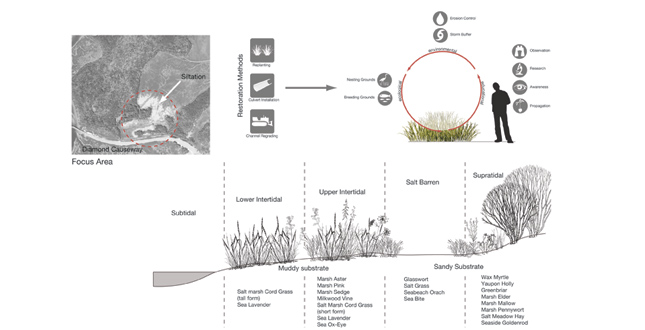 Close Me!
Close Me!Saltmarsh Restoration: Methods + Restoration + Benefits. The construction of the Diamond Causeway in 1972 had devastating impacts on the surrounding salt marsh communities, increasing siltation levels and choking off sections to tidal flow. Restoration efforts aid in reestablishing this important ecosystem, incurring ecological, environmental, and educational benefits.
Download Hi-Res ImagePhoto: Wes Ryals
Photo 12 of 15
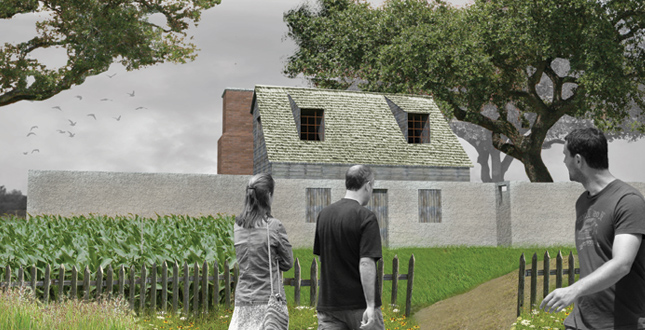 Close Me!
Close Me!Stationing Opportunities: Establishing Historical Connectivity.
Download Hi-Res ImagePhoto: Wes Ryals
Photo 13 of 15
 Close Me!
Close Me!Stationing Opportunities: Establishing Ecological Awareness.
Download Hi-Res ImagePhoto: Wes Ryals
Photo 14 of 15
 Close Me!
Close Me!Stationing Opportunities: Establishing Ecological Awareness.
Download Hi-Res ImagePhoto: Wes Ryals
Photo 15 of 15
Project Statement
Upon its founding in 1736, Wormsloe has exhibited a diverse ethnographic and environmental history. The site’s environmental stewardship sets a precedent for post-wilderness conservation, revealing a close partnership between human and environmental interaction. Consequently, Wormsloe is poised to become a leading contributor in the study, interpretation, and outreach of environmental history. The project mission focuses on establishing infrastructure and program improvements, spearheading an initiative that weaves sustainable design solutions with the site’s historic fabric.
Project Narrative
Current Land Use + Context
The Wormsloe property encompasses 822 acres and lies approximately 11 miles southeast of the city of Savannah, Georgia. The property is flanked by the Moon River to the west; the Isle of Hope River to the east; the Diamond Causeway to the south; and the historic Dupon subdivision to the north.
Ownership of the property is subdivided amongst the private estate, Wormsloe Foundation, and the Georgia Department of Natural Resources. The property remained largely private domain until 1927, when the family, spurred by financial difficulties, opened the old plantation grounds to a paying public. Today, the focal features of the property continue to be the 1.5 mile Live Oak allée entrance drive as well as the colonial era remnants of Noble Jones’ fortified house. A visitor center and living history demonstration area provide some context to a visiting public. However, interpretation of the landscape remains largely fragmented, and in some cases, ignored completely.
The initial program for the site called for infrastructure improvements necessary to accommodate an annual visitation increase of 50,000 to 250,000. A new visitor center has been proposed along with complimentary research and dormitory buildings. Additionally, the site seeks to establish itself as a leading contributor in field of environmental history through research and educational opportunities.
Environmental Degradation
Two events feature prominently in the environmental degradation of the site. The first occurred in 1972 with the construction of the Diamond Causeway, an important connection linking Savannah to Skidaway Island. The connection effectively bisected important salt marsh communities, choking off tidal flow north of the causeway. Additionally, excess fill was deposited north of the causeway, resulting in thinly vegetated areas of high marsh as well as upland hammock. Furthermore, increased salinity levels have led to the formation of extensive salt flats devoid of vegetation. Recent soil sampling of the site area suggests the buried marsh to be under 2 to 3 feet of fill. Recent plans to widen the causeway place additional strain on the functionality of the delicate estuarine environment.
A second disruption occurred in 1974 with an infestation of Southern Pine Beetle on the Isle of Hope. Subsequently, a large tract of old-growth forest had to be clear-cut to avoid further contamination.
Guiding Principles + Objectives
Design strategies took a comprehensive and holistic approach accounting for cultural, economic, and environmental factors. A strategic framework was established for reenvisioning the cultural landscape in accordance with the Wormsloe Foundation’s goal “to conserve the natural, historic, and archaeological features of the site thereby contributing to public education, research, inspiration, and enjoyment.”
Economics+ Self-Supporting Infrastructure
Projects of similar size or scope were referenced as a basis for establishing diversified programming. Design strategies focused on connecting to a broad range of constituents, while incorporating infrastructure improvements necessary to accommodate a regenerative economics’ model, allows for additional development opportunities.
Cultural Landscape Report
An initial investigation revealed Wormsloe’s eligibility to be included on the National Registry of Historic Places (NRHP). Consequently, the property must undergo a Cultural Landscape Report. The initial development of the report shall constitute a basis for design operations, yielding critical information relevant to site and program development. Additionally, the report lends itself to low-impact development, minimizes loss to historically significant features, and brings a greater understanding of associations between layers.
Design Strategies + Program Development
Site Connectivity + Infrastructure Improvements
Connectivity has been achieved while mitigating impact to archaeologically and environmentally sensitive areas. In particular, vehicular access to the Live Oak allée has been rerouted in favor of an eco shuttle service. Practical phasing options provide a framework for continued development as necessitated by visitation levels.
Ethnographic Programming
A thorough historical analysis was instrumental in determining layers of interpretation. However, archaeology will also play a vital role as the only authorized excavation took place in 1968-69 and current work has been limited to the 18th century rice mill. Programming focuses on presenting a holistic experience, bringing greater attention to associations across layers. A renewed focus has been placed on Pre-Columbian inhabitation by the Guale Indians as well as the cultural contributions Africans in transforming the agrarian landscape. Furthermore, contributions of African slaves are to be connected to the proposed Gullah/Geechee cultural heritage corridor.
Environmental Programming
Environmental programming was centered on 4 principles: (1) restore functionality to ecosystems, (2) achieve species diversity (3) reconnect fragmented ecosystems, and (4) maximize educational opportunities.
A reestablishment of ecosystem diversity on site was guided by the implementation of sustainable land management practices, including the eradication of invasive species and the restoration of prescribed burns. Restoring functionality involved a bottom-up approach, designing for functioning members of the intended ecosystems. The restoration of flow to Jones’ Narrows constitutes one example of reconnecting fragmented systems. Design strategies include removing excess fill, improving tidal flow, and incorporating wetland restoration strategies in order to ensure the vitality of salt marsh communities. The promotion of healthy ecosystems, fostered by sustainable environmental stewardship strategies, safeguards the landscape in perpetuity for subsequent generations.
Educational Programming
By siting the visitor center at the entrance of the property, visitors are immediately oriented to the history of the site, from which they can proceed to their area of interest. A series of interpretive trails and contact nodes sited along the path system maximize visitor exposure to the temporal landscape. Additionally, portable audio devices can be utilized on site to gain access to previous exhibits, enabling individually-tailored experiences. Incremental program phasing provides added layers of complexity to the landscape. Furthermore, a research center and dormitory complex allow educators continued access to the site.
Conclusion
Sustainable design solutions seek to continue the cultural legacy initiated by Noble Jones in 1736 through the promotion of a didactic landscape which is layered, resilient, and adaptive to its environment. Educational opportunities reconnect visitors with the temporal landscape; moreover, an enhanced connectivity to one’s environment strengthens cultural identity, engendering a sense of place.
Additional Project Credits
Wormsloe Institute for Environmental History
Sarah Ross, Director
Craig and Diane Barrow





